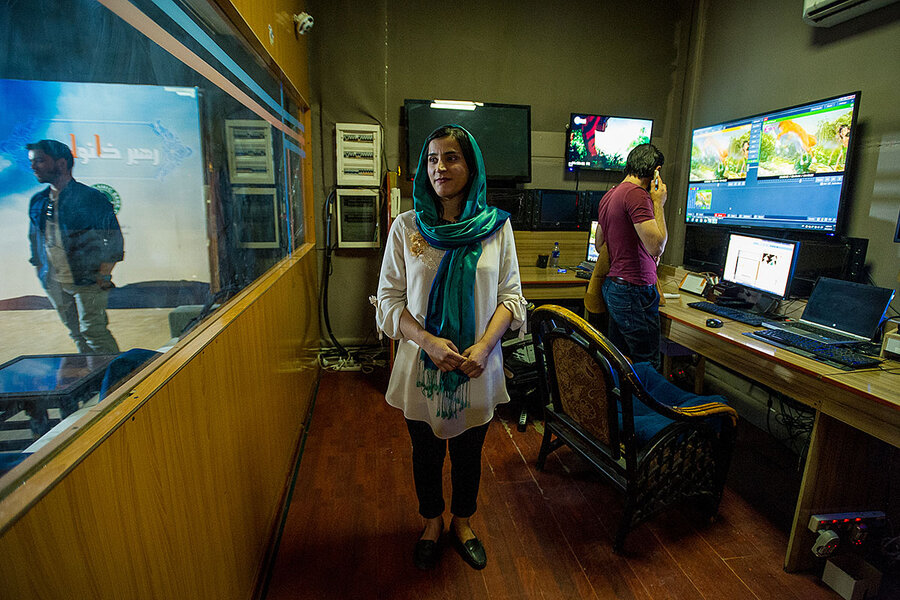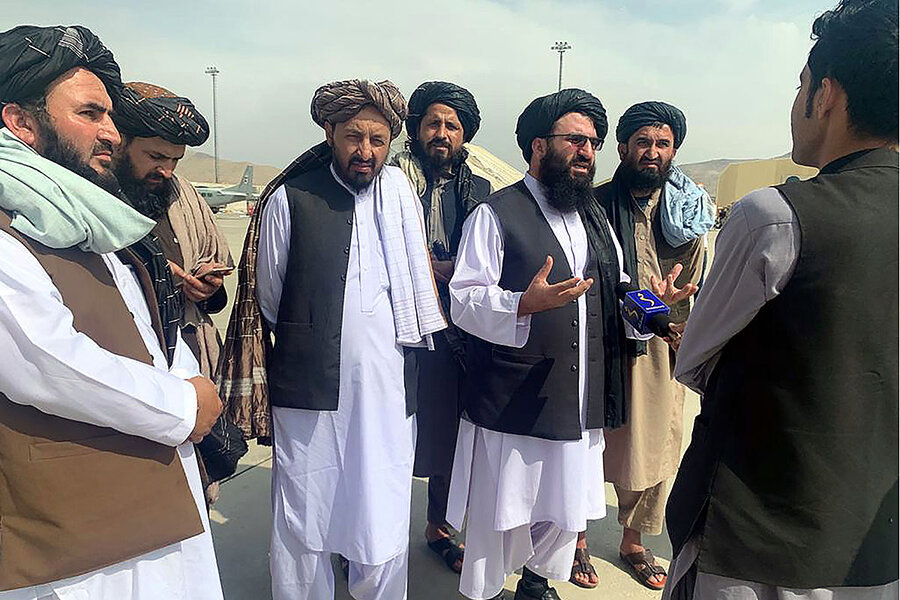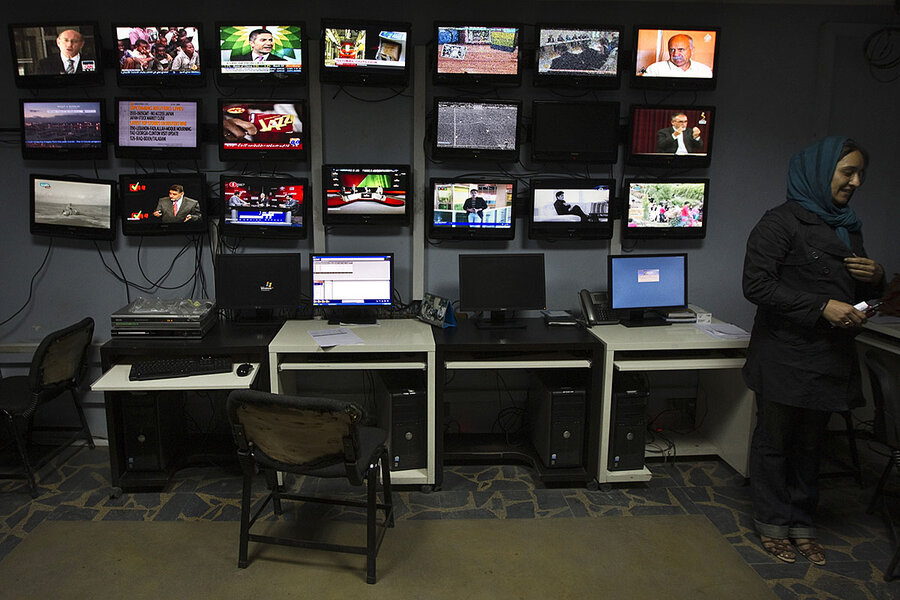Afghan journalists’ battle: To keep free expression alive
Loading...
| LONDON
Over 20 years of an American and Western presence that enabled a vibrant media landscape in Afghanistan, the Taliban and other Islamists often targeted journalists in suicide attacks and bombings. Yet today the Taliban have officially declared the media “free and independent” to work, unlike when they last ruled Afghanistan from 1996 to 2001.
Still, Afghan journalists are reeling from beatings, detentions, and ever-tighter Taliban restrictions on what can be reported that raise questions about the future of free expression in Afghanistan.
Why We Wrote This
How well, and how long, the Taliban will tolerate independent journalism will be telling. Many Afghan reporters fled amid threats, but others stayed, boldly continuing to do their jobs.
“Anyone who says we are not doing our job is obviously not watching our TV stations and programs,” says Saad Mohseni, head of the Moby media group, which includes the 24-hour Tolo News channel. “But for how long? I’m not sure,” says Mr. Mohseni, contacted in London. Tolo News notes that 153 local media organizations have shut down across Afghanistan in the past month.
“I don’t want to get too optimistic, because I know things can change quickly,” Mr. Mohseni says. “And I don’t want to be too pessimistic, because so far [the Taliban] have given us enough freedom for us to be able to continue with our work.
“It’s not even a day-to-day proposition,” he says. “It’s an hour-by-hour proposition.”
The message of the vengeful Taliban fighters was clear when they raided the offices of state-owned Radio Television Afghanistan (RTA) in Logar province, as the region south of Kabul fell to the jihadist juggernaut in mid-August.
An Afghan journalist describes being severely beaten as the Taliban destroyed his computer with an assault rifle, then trashed the television and radio studio.
“Shut up and don’t raise your voice!” a fighter warned the journalist. “If you raise your voice, we will kill you.”
Why We Wrote This
How well, and how long, the Taliban will tolerate independent journalism will be telling. Many Afghan reporters fled amid threats, but others stayed, boldly continuing to do their jobs.
For days afterward, he had nightmares that the Taliban would break into his house and slay him – as they had slaughtered scores of journalists, civil society activists, and officials in a recent assassination campaign.
Instead, the journalist received a call from the Taliban, ordering him to “return to his duty” and broadcast again – but under Taliban direction.
“They need us for some time because there is no technical person in their team,” says the journalist, who asked that his name not be used for his safety. “Maybe they will kill us in the near future.”
The fluctuating circumstances of reporting in Logar are a reflection of the high-stakes uncertainty facing journalists across Afghanistan, as they struggle to navigate what some might call the new “Age of the Taliban.”
Twenty years of the American and Western presence enabled a vibrant and freewheeling media landscape, during which the Taliban and other Islamists often targeted journalists in suicide attacks and bombings.
Yet today the Taliban have officially declared the media “free and independent” to work, unlike when they last ruled Afghanistan from 1996 to 2001. The militants have themselves become adept at using the press and social media as tools to gain diplomatic and military advantage.
Still, Afghan journalists are reeling from beatings, detentions, and uncertainty – even from an exodus of colleagues from the country, as the Taliban impose ever-tighter restrictions on what can be reported – that raise questions about the future of free expression in Afghanistan.
“An hour-by-hour proposition”
“Anyone who says we are not doing our job is obviously not watching our TV stations and programs,” says Saad Mohseni, head of the Moby media group, which includes the country’s largest private broadcaster, Tolo TV, and its sister, 24-hour channel Tolo News. Journalists “are reporting on things. They may do it in a slightly different way.”
“But for how long? I’m not sure,” says Mr. Mohseni, contacted in London. Tolo News notes that 153 local media organizations across nearly two-thirds of Afghanistan’s provinces have shut down in the past month.
“I don’t want to get too optimistic, because I know things can change quickly,” he says. “And I don’t want to be too pessimistic, because so far [the Taliban] have given us enough freedom for us to be able to continue with our work.
“It’s not even a day-to-day proposition,” says Mr. Mohseni. “It’s an hour-by-hour proposition.”
Even with Afghanistan now under Taliban control, Tolo News has reported on allegations of Taliban human rights violations in the Panjshir Valley, as well as on anti-Taliban street protests and the beatings of journalists covering those protests. They include brutalities meted out last week with batons, electric cables, and whips against two staffers of the Etilaat Roz newspaper.
Yet when photographer Nematullah Naqdi asked why he was being beaten, he was told: “You are lucky you weren’t beheaded,” Agence France-Presse (AFP) reported.
Journalists seen as spies and enemies
Journalism has always been a hazardous profession in Afghanistan, with even top local news organizations subjected to abuse and raids by disgruntled officials of previous U.S.-backed governments.
And over the years the Taliban, as well as Islamic State jihadists, added to the pressure – and the toll of scores dead – as they accused the media of spouting pro-Western “propaganda.”
“They see us as enemies,” Etilaat Roz reporter Taqi Daryabi told AFP after his beating.
Indeed, Taliban outlets in the past often criticized journalists as “spies of infidel occupiers.” Tolo TV itself was targeted by the Taliban in 2016, when a suicide bomber struck an employee bus, killing seven. Though the Taliban then called the entertainment channel “the country’s largest network for promoting obscenity, irreligiousness, foreign culture and nudity,” now a Taliban official has appeared on Tolo News, interviewed by a female anchor.
“You know, Afghans will get the news somehow,” says Mr. Mohseni. “And this is what we are telling the Taliban, that freedom of expression is good. ... So there’s this ongoing dialogue that may lead to nothing. But we have to give it a shot.
“This is the party that has God on its side. How willing are they to be challenged?” he says. “What if a particular minister is challenged? That’s when the test will come.”
“You are not allowed”
For some Afghan journalists, the verdict is already in, and it is devastating. Sheba Popalzai, a news reporter for Khurshid TV, a culture and games channel that is now off the air, says she is “at home in despair and hopeless.”
“After 16 years of study and aspirations and four years working in different media, I did not think I would ever face such a bad fate,” Ms. Popalzai says in Kabul.
“The media that broadcast before the Taliban is different from the media broadcasting today,” she says. “Every journalist has to change the way they work in order to protect their life, because they are afraid of being arrested and beaten by the Taliban.
“I dreamed of being a prominent journalist,” says Ms. Popalzai. “But with the arrival of the Taliban, all my hopes were dashed and buried forever.”
Indeed, new restrictions have especially grated on female journalists. Days after Kabul fell, senior Taliban leader Wahidullah Hashemi said women “do not have the right” to be reporters or news anchors, which “is not allowed in our government.”
Proof came that very day, when Shabnam Dawran, a widely recognized anchor for RTA, was turned away from work by the Taliban because she was female, despite her staff press card.
“They told me that the regime has changed. ‘You are not allowed, go home,’” she said in a tweeted video.
That is no surprise to Shogofa Sediqi, chief director of Zan TV (Women’s TV), who has for years received death threats for her work at a channel dedicated exclusively to women’s issues and empowerment.
Zan TV closed abruptly with the Taliban arrival. Disbanded, too, is Zan TV’s journalism academy for women, which produced 60 graduates.
“It is a challenging time for [female journalists] these days,” says Ms. Sediqi, contacted from a quarantine center in Canada after a rushed exit from Afghanistan. “All our achievements were destroyed and wasted. They are worried and have been scared. ... Nothing exists there to progress their career. ... Everything has changed.”
She says she does not believe Taliban assurances about accepting an open media.
“How is it possible to believe in a group of people who have always been against women’s rights and were killing children, and made suicide attacks among ordinary people?” says Ms. Sediqi. “If they changed their mindset, they would never put restrictions on freedom of expression, the media networks, [or] women working and the clothes they wear.”
Defending Afghan women is a job far from done for Ms. Sediqi. “Our struggle is ongoing. We didn’t accept defeat,” she says.
But the price has been high, and paid repeatedly before and after the Taliban takeover.
“Fear in our hearts”
Ms. Sediqi’s sister, Zahra, was a television presenter for Ariana News, and lost her best friend and fellow Ariana presenter Mina Khairi in a car bomb on June 3 that was claimed by the Islamic State.
That explosion made her “very discouraged for my career because I lost one of my colleagues in front of my eyes,” says Zahra Sediqi, now also in quarantine in Canada.
Fellow journalists in Kabul tell her of “vast changes” to media programs since the Taliban took over, and that their jobs are getting more difficult.
“With each passing day, the Taliban are narrowing the field of work for journalists, and leaving fear in our hearts,” says Ahmad Navid Kavosh, a reporter for Khurshid TV.
While reporting at the Kabul airport on Aug. 18, he was beaten by one Taliban fighter on his shoulder, back, and legs, while another pointed his Kalashnikov assault rifle at him and said, “Go, or we will break your camera and imprison you!”
Mr. Kavosh says he remains traumatized.
“I censored myself to survive, and this is the heartache of hundreds of Afghan journalists who are in complete despair,” he says.
“When they shut the mouth of a journalist who has always spoken freely, revealed the truth, and people expect him to [do so], it is natural that he is not alive, but among the living dead.”










